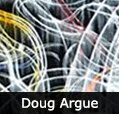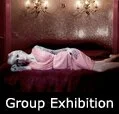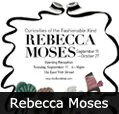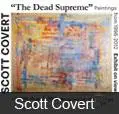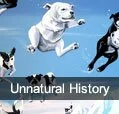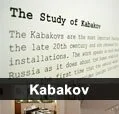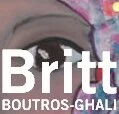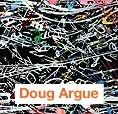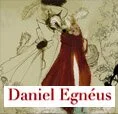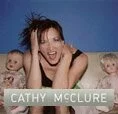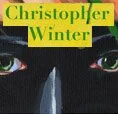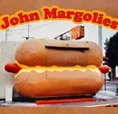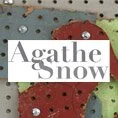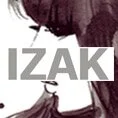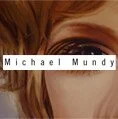Christopher Winter Unnatural History
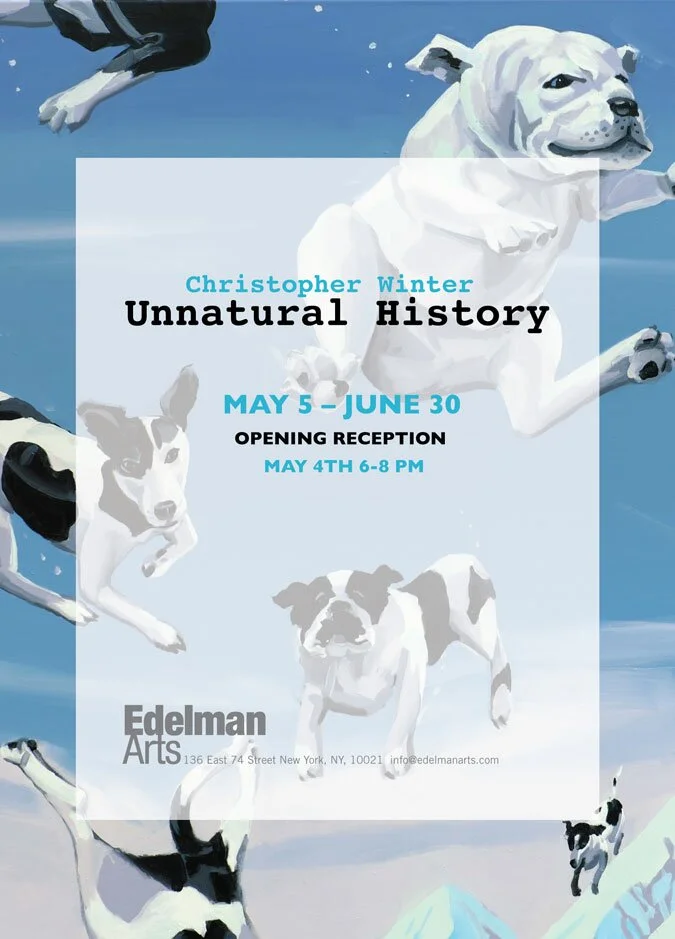
Traffic Art Space is pleased to announce a new series of work by Christopher Winter entitled Unnatural History, exhibited in conjunction with Edelman Arts. The exhibition opens May 5th- June 30th.
Christopher Winter’s singular paintings remind us that, once upon a time, art and magic emerged simultaneously, indeed were one and the same.
Caves in the Paleolithic era were not clean, well-lighted spaces, and cave paintings were not viewed in the detached, observer-and-observed way we now regard art. They were magic in which viewers were participants. The first paintings were likely experienced as genuinely living entities, gateways into the spirit-world, the mind’s own terra incognita. 32,000 years on, give or take a decamillenium, we find ourselves in the present, on a darkly magical mystery tour with artist-magician Christopher Winter as our guide.
This time round, Winter pulls more than a few rabbits from his prestidigitator’s hat, with one painting of a rabbit emerging from the magician’s topper, and several paintings of rabbits and other domesticated fauna leaping through the skies. Aloft before demure storybook mountain valleys, these gravity-defying creatures are, well, hare-raising.
Christopher Winter, an Englishman now residing in Berlin, has recreated his own displacement in his paintings. Rendered in twee, serene English tints, the undulating mountainous landscapes become a devil’s playground for Teutonic Gothic menace. Winter exults in the liminal—the weightless borderline between innocence and experience, the pastoral and the eldritch, the familiar and the uncanny, the perceiver and the perceived. We’re back in the cave, but the walls are now white and the lighting markedly improved.
The concept of the uncanny (Ger. Das Unheimliche, “the opposite of what is familiar”) was first limned by German psychiatrist Ernst Jentsch in a 1906 essay. Jentsch defines the Uncanny as a product of “intellectual uncertainty… something one does not know one’s way about in.” Experiencing the uncanny, we find ourselves at once attracted and affrighted: cognitive dissonance at its finest. On that note, Edelman Arts welcomes you to Christopher Winter’s “Unnatural History.” Make yourselves uncomfortable.
—Fayette Hickox
Huxley’s Guide to Switzerland, 2012, Acrylic on canvas, 51 ¼ x 90 ½ in (130 x 230 cm)
Christopher Winter on “Unnatural History”
Fayette Hickox: What do you mean by “Unnatural History”?
Christopher Winter: “Unnatural History” not only refers to the state of the animals in the new paintings but also human nature itself. Are we natural? The effect I want to achieve is that of walking through an idyllic landscape after taking mind-altering drugs. It’s not about surrealism— the paintings are grounded in objective reality, with clear lines and
vivid colors.
FH: What were your inspirations for the new paintings? If not surrealistic, they are mindbending.
CW: Good. I’ve been looking into staged illusions from magicians and cheap tricks. Optical illusions play a great role in painting and I’ve been exploring how painting on a two-dimensional canvas affects perceptions. Altered states of perception interest me as well—both real and enhanced by chemicals.
FH: Can you tell me how this shows up in the paintings?
CW: In the painting “Huxley’s ‘Guide to Switzerland,’” an adolescent couple is levitating in the Swiss Alps, seemingly following the path of the river beneath them. The title is inspired by Aldous Huxley’s famous experiments with mescaline that he chronicles in his book “The Doors of Perception.” The painting “Comfortably Numb” refers to the Pink Floyd
song with a similar theme.
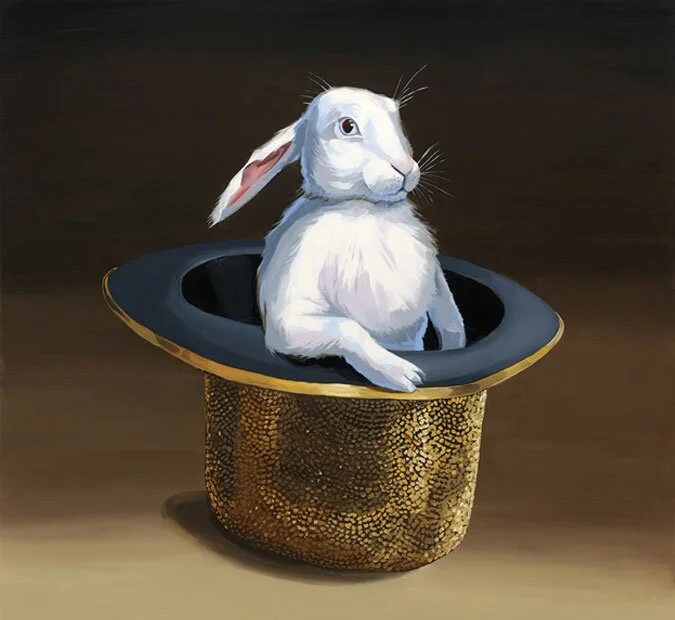
FH: There are some fresh additions to your subject matter. While we still see children on the cusp of adolescence, there are bulldogs and rabbits—lots of them—and the creatures seem to be floating.
CW: Rabbits—or, if you wish, hares—have turned up in art and literature in a number of guises. I’m on something of an art historical roller coaster ride with the hares, playing off Durer’s “Young Hare” from 1502, the White Rabbit in Lewis Carroll’s “Alice in Wonderland,” Joseph Beuys’s 1965 performance “How to Explain Pictures to a Dead Hare” and Jeff Koon’s “Rabbit”
from 1986.
I wanted the hare, this overused art icon, to experience air travel in the petit bourgeois idyll of an unspoilt Alpine landscape. In the earlier uses of the hare I mentioned, the creatures don’t even get to hop: I allow them to fly. In a few of my paintings, the rabbits are pulled out of hats, but more often they are simply in mid-air, undisturbed by their sudden ability to defy gravity. They are posed, their feet akimbo, as if juggled by an unseen source. In my painting “Hybrid I,” the hare becomes a laboratory experiment, a genetic aberration with new zebra markings.
FH: These paintings are in one sense representational, and yet, and yet …
CW: In these works, I’m trying to create extreme moments. I’m relating the history and aesthetics of painting to Pop Art and comics, trying to challenge the audience in every respect. By inventing bizarre situations, I want to take representational painting to its limits—the borderland between dream and reality—mixing up art historical references with
brazen naïveté. Christopher Winter (b.1968) resides in Berlin. He is the cofounder of the artist group Special X with fellow artists Shiho Yuki and Eva Hauman to highlight the crisis points in the art world by subverting art world practices. A graduate of the Camberwell School of Art in London, his works have been shown in museums and galleries throughout Europe and in New York. His extensive retrospective solo exhibition “Wildlife” was exhibited at the Reiss-Engelhorn Museum (REM) in Mannheim, Germany, in 2010. In September 2012, his “Gingerbread House” installation—a 14-foot-high replica of the Bates Motel from Alfred Hitchcock’s “Psycho”— will shown at the Berlinische Galerie Museum. Christopher has curated exhibitions at Tape Gallery, Berlin, including 2010’s “Cover Up,” featuring Thorsten Brinkmann, Olaf Breuning, Marcel Dzama and Leigh Bowery.
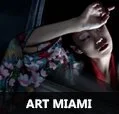 Nov 17 2014
Nov 17 2014


